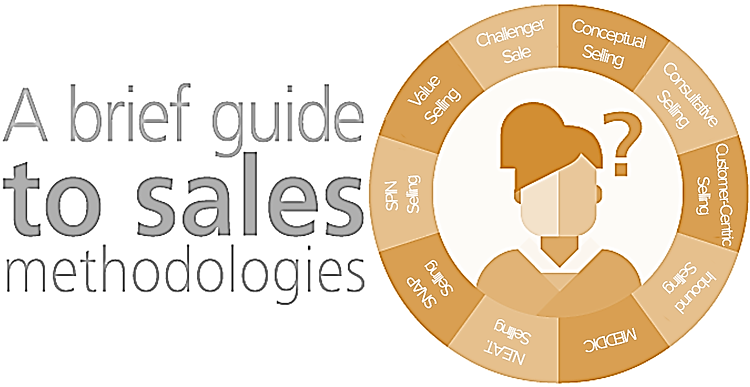Every sales department wants to close more deals. Fortunately, there’s an easy way to make this happen: implement a proven sales methodology that will enable your sales team to be more effective.
Don’t believe us? Try this stat on for size: 90% of companies that follow a guided sales process rank as high performing. In other words, you’ll find more success if there’s a method to your madness.
The only thing you need to decide is which sales methodology is right for your team.
There are many options available to you—we cover 17 of them in this article. Before we get to that though, we’ll explain what a sales methodology is and criteria to choose between them. Let’s dive in!
Table of Contents
- The Challenger Sale
- Conceptual Selling
- Consultative Selling
- Customer-Centric Selling
- Inbound Selling
- MEDDIC
- NEAT Selling
- SNAP Selling
- Solution Selling
- SPIN Selling
- Sandler Selling System
- Value Selling Framework
- Gap Selling
- Target Account Selling
- Command of the Sale
- SPICED Selling
- CHAMP
What is Sales Methodology?
Sales Methodology is an element in the sales process that refers to the framework, philosophy, or general tactic that guides how a salesperson approaches each step within the process.
Sales Methodology bridges the gap between what needs to be done and how to do it.
The most effective sales methodologies turn goals into actionable steps that sales leaders can measure and monitor. Many sales methodologies are available, some aligning with a specific stage of the sales cycle and others with the entire process. A sales methodology primarily focuses on one specific aspect of the sales process, such as qualification or discovery, since it provides deeper insight into that particular process and assists sales leaders in identifying areas for improvement.
Implementing a sales methodology can help your company earn customers in B2B environments. The sales model you choose will dictate your sales process. Because each company develops its own sales process according to its market and vertical, a sales methodology that works for one company won’t necessarily work for another. This is why it’s important to choose a sales methodology that aligns with your business goals, strategies, and needs.
It’s also critical to tailor the methodology for your sales team. Customization allows you to tailor the methodology to your specific organization’s needs, making it more effective and less likely to be abandoned.
How to Choose a New Sales Methodology for Your Sales Process
Now that we know what a sales methodology is, let’s talk about choosing one for your sales team. Consider these four things before you implement a new selling system for your reps to follow:
Your Goals
What do you want your sales department to accomplish? Your sales goals will affect the sales methodology you choose because different methodologies will help you achieve different things.
If you want to increase revenue, select a sales methodology that prioritizes closed deals. If you want to improve your prospecting processes, go with a methodology that will help you connect with more leads.
Before you do anything, identify your objectives. This will make it easier to choose the right methodology.
Your Sellers
Think about the reps on your sales team. What are their strengths and weaknesses? Ideally, you’ll choose a sales methodology that magnifies the things they’re good at, while downplaying the things they can’t do.
Just remember, salespeople come and go. The average tenure for a sales rep is only 18 months. So, unless you always hire similarly talented people, don’t prioritize your reps too much when choosing a methodology for your sales team. They should be a factor, but not the most important one.
Your Industry
Selling solar panels to residential customers in your home town is very different from selling maintenance, repair, and operating (MRO) solutions to Fortune 500 companies. Choose a sales methodology with this in mind.
Think about the products you sell, the complexity of your deals, and the length of your sales cycle. Then select a sales methodology that can best accommodate these important factors.
Your Customers
Finally, who do you sell products and or services to?
You’ll want to go with a sales methodology that these people will connect with. This is another reason why understanding your ideal customer profile (ICP) is essential to your success in sales.
The 17 Best Sales Methodologies
1 | The Challenger Sale
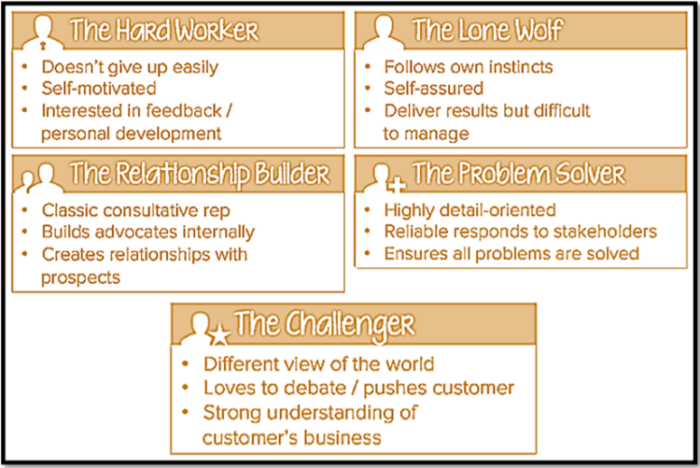
The 2011 book authored by Matthew Dixon became an overnight sensation that transitioned into one of the most popular and best sales methodologies.
This methodology categorizes sales reps into 5 profiles:
- The Hard Worker: These reps are very self motivated. They seek out feedback because they’re always interested in improving their skills. Most importantly, they refuse to give up.
- The Lone Wolf: These reps are self-assured and follow their own instincts. While these traits are admirable, they can make the reps that have them more difficult to manage.
- The Relationship Builder: These reps take a consultative approach to sales. Their main goal is to build relationships with potential buyers who will advocate for them inside the buyers’ companies.
- The Problem Solver: These reps view sales as a puzzle. As such, they’re extremely detail-oriented, responsive, and able to solve many different problems for their customers.
- The Challenger: These reps view the world differently than the reps above. They love to debate customers, pushing them towards solutions that they know will benefit their buyers.
As you’ve likely guessed, the book states that challenger-type sellers are the most successful. Challengers make consumers aware of potentially game-changing challenges and opportunities in their market and then offer effective, tailored solutions. They use the “teach-tailor-take” tactic to close sales.
The Challenger Sale revealed some shocking performance trends:
- 40% of high sales performers primarily used a Challenger style compared to one of the 4 other sales styles identified
- High performers were more than 2x likely to use a Challenger approach than any other
- More than 50% of all-star performers fit the Challenger profile in complex sales
- Only 7% of top performers took a relationship-building approach, the worst performing profile
2 | Conceptual Selling
Stephen Heiman and Robert Miller developed conceptual selling, a sales model that believes that customer interactions are too important for sales organizations to leave to chance. Their approach is centered on customer-focused interactions, which help salespeople better prepare for their time with customers, resulting in purposeful meetings and win-win outcomes.
Conceptual selling as a sales method encourages sales reps to ask smart questions.
There are 5 categories in this sales model:
1. Confirmation Questions: Reaffirm information
Example: I understand you’re in the distributor and technical solutions business and are looking for a product to better manage reps and hold them accountable. Is this correct?
2. New Information Questions: Clarify the prospect’s concept of the product or service while also exploring the desired result
Example: Can you tell me exactly what problem a field/outside sales app would solve for you? In the big picture, how would solving that problem help your company?
3. Attitude Questions: Seek to understand and relate to prospects on a personal level by discovering their connection to the project
Example: Why hasn’t it been addressed before? How are you currently doing things?
4. Commitment Questions: Inquire after a prospect’s investment in the project
Example: How important to you is getting a product in place? What are your primary roadblocks to implementing our product?
5. Basic Issue Questions: Raise potential problems
Example: Are you comfortable with the annual cost and required onboarding and setup fee?
3 | Consultative Selling
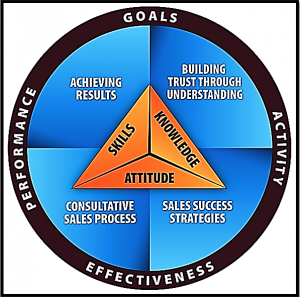
This sales methodology established its roots in solution selling where an experienced salesperson’s expertise, industry knowledge and reputation is leveraged. Instead of telling prospects what they need, this investigative approach engages prospects through thought provoking questions, helping them identify their own pains.
Ultimately, prospects guide themselves into making their own decision.
The number one trait of effective consultative selling is the art of asking questions that dig up quality responses. Start by building credibility by demonstrating that you understand what’s going on with their business.
Consultative selling techniques are rooted in the selflessness of the salesperson. It’s not about proving that your product or service is the best, it’s about finding the solution that’s right for the customer.
4 | Customer-Centric Selling
There’s no shocker here — the focus of this sales model is on the consumer’s challenge, goals, and convenience. The objective is to become a knowledgeable, trusted advisor to the client. Customer-centric selling (CCS) centers on defining and implementing a repeatable and scalable buyer-driven sales process to achieve success and exceed goals.
There are 8 components of this sales model:
- Converse situationally compared to making presentations
- Ask relevant questions as opposed to offering opinions
- Solution-focused instead of relationship-focused
- Target decision makers instead of users
- Promote product usage to gain interest instead of the product alone
- Focus on being the best seller instead of the busiest
- Close on the buyer’s timeline instead of the seller’s
- Empower buyers to buy as opposed to convincing them to buy
5 | Inbound Selling
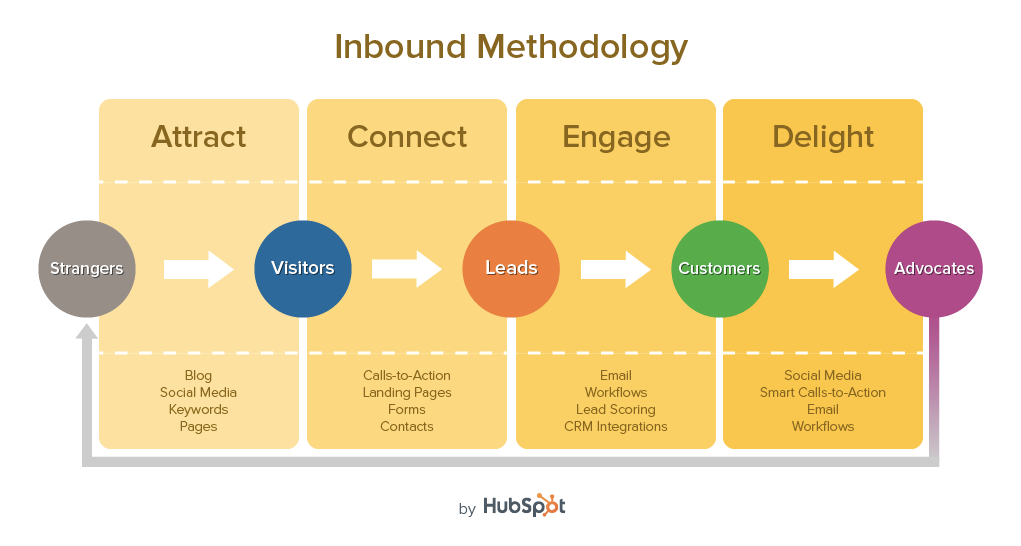
You are likely familiar with the inbound methodology, as it’s become more popular with internet development. The framework works on the premise that inbound sales are those that come to you, while outbound sales are those you seek out.
With this sales funnel methodology, marketing strategies are tightly intertwined with sales processes and goals. Inbound sellers attract consumers by creating messaging opportunities for them to actively engage with the seller’s company.
It eliminates pushing “salesy” scripts to prospects by “pulling” them in. Inbound sellers utilize data and analytics to hyper-personalize messages and lead customers toward desired actions.
Note: Compared to the inbound selling methodology, outbound selling encompasses many traditional selling techniques, where sellers initiate conversations with prospects via cold or warm calls, chat sessions, and email outreach.
6 | MEDDIC
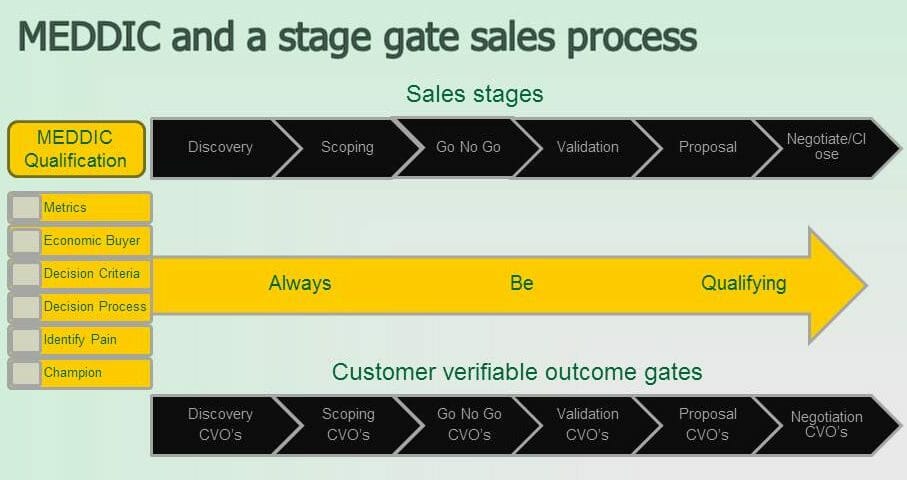
The MEDDIC sales methodology is all about lead qualification. By asking yourself specific questions regarding the person or organization you want to sell to, you can determine if they’re a good fit.
MEDDIC was originally created in the 1990s by Jack Napoli, who used the methodology to turn his tech company, PTC, into a billion dollar juggernaut. It’s been used by countless companies since.
MEDDIC stands for:
- Metrics: Which metrics matter most to this buyer?
- Economic Buyer: Who makes the financial decisions?
- Decision Criteria: What requirements does my product need to meet?
- Decision Process: What steps does the buyer take before making a purchase?
- Identify Pain: What pain points does my product fix for this buyer?
- Champion: Who will champion my product inside the buyer’s company?
This sales method is a highly disciplined, tech-driven and tightly controlled approach the sales process. Through metrics and other relevant data, quantitative standards are established for lead qualification, which requires the search and nurturing for a “champion” in the prospect that advocates for the seller’s brand or solution.
Note: another version of MEDDIC was created called MEDDPIC that evolved from this original methodology.
7 | N.E.A.T. Selling
Sales reps are often portrayed in popular culture as greedy individuals who only care about meeting quota and driving revenue—even if it means neglecting customer needs. The NEAT selling technique aims to flip this stereotype on its head by encouraging sellers to listen to potential buyers and act accordingly.
NEAT stands for:
- Need: What does your prospect really need? Skip past surface issues to find core problems.
- Economic Impact: How do these needs affect the prospect’s finances? And how can you help?
- Access To Authority: Who can sign off on a deal? And how can you reach this person?
- Timeline: How long will it take to get a deal done? Build a practical timeline.
NEAT Selling is a modern spin on the BANT, ANUM, and AN methodologies:
- BANT is a sales qualification process based on a prospect’s Budget, Authority, Need, and Timeframe
- ANUM is based on a prospect’s Authority, Need, Urgency, and Money
- AN is tailored toward Authority and Need
BANT, ANUM, and AN were only good approaches in the past. In today’s world, you will find much more sales success if you apply the NEAT method to your sales process. This is because the NEAT framework can handle nonlinear paths to purchase and caters to prospects’ actual needs.
8 | SNAP Selling
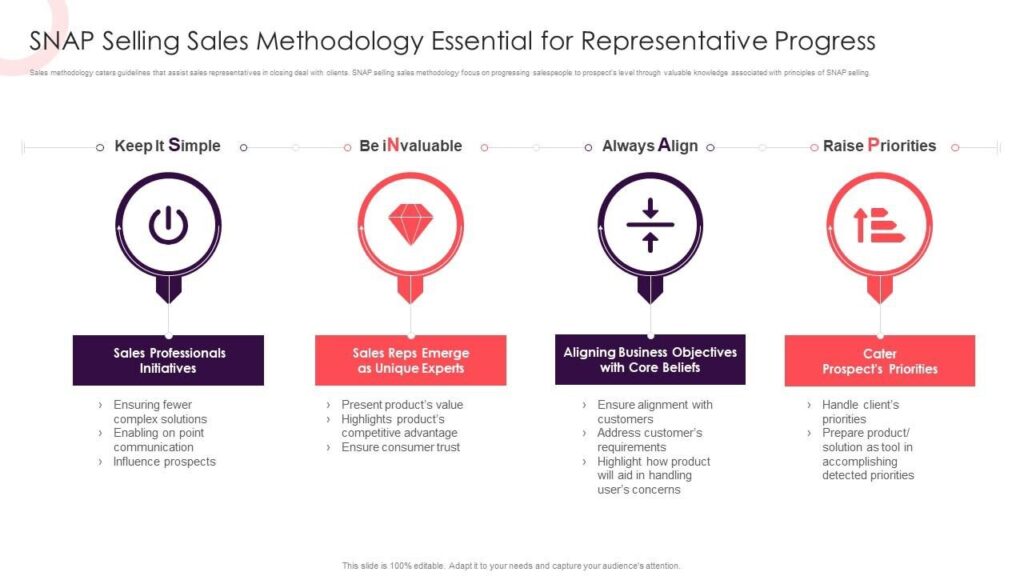
Source: SlideTeam
Established by Jill Konrath in 2012, SNAP aims to speed up the sales and buying process under the assumption that prospective buyers are busy and distracted.
SNAP stands for:
- Simple: Keep it simple by making it easy for prospects to change their current habits and adopt what you’re selling.
- INvaluable: Your prospects (buyers) or overwhelmed. You need to be unique experts who stand out and showcase the value of your product.
- Align: Make people want to buy from you by aligning your position with their beliefs and needs.
- Priority: Focus on what the prospect is focused on to win deals.
SNAP Selling is one of the best sales methodologies because of how it identifies three critical decisions involved in a sale:
- Allowing access
- Choosing to move away from the status quo
- Changing resources
The goal is to use these mini-decision milestones to more effectively keep deals on the right path.
9 | Solution Selling
One of the many unique types of selling is solution selling, which drives focus away from the product-centric approach and toward the benefits, impact and relevance of a custom solution.
Made popular in the late 1980s, this approach dives into each customer’s unique situation to accurately identify pain points and establish an agreed upon criteria set for an acceptable resolution. The technique has evolved to adapt to changes in buyer maturity and business landscape.
Solution selling includes supporting processes, tools and critical skill development. It helps salespeople provide higher and differentiating value to buyers by shaping how customer engagement occurs.
10 | SPIN Selling
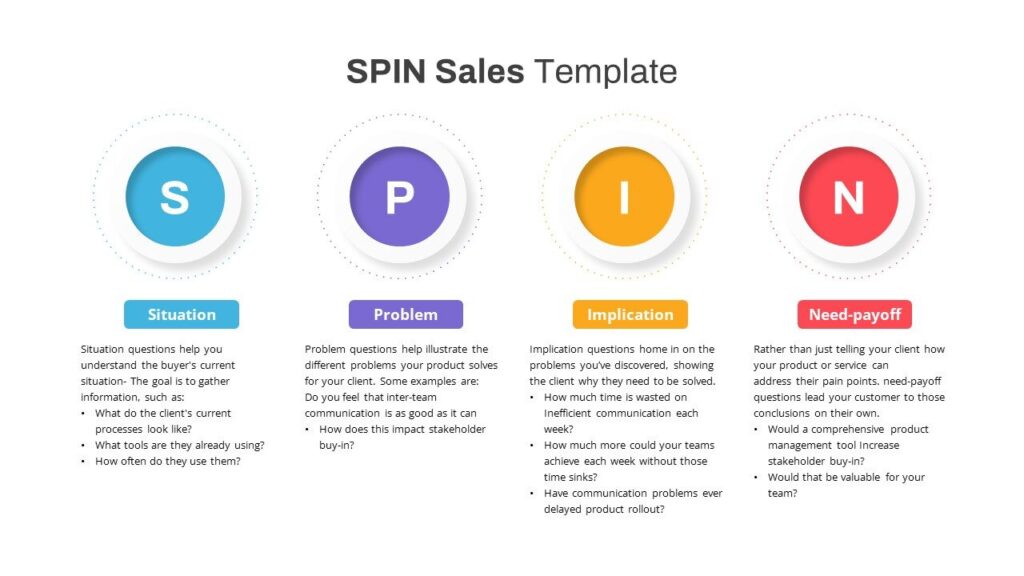
Source: SlideBazaar
Based on Neil Rackham’s book of the same name, SPIN Selling helps sales reps close big, complex deals—especially in the B2B market. It works by asking prospects specific kinds of questions in a systematic way, which allows reps to gather the information they need to close deals consistently.
SPIN stands for:
- Situation: How do you track what’s happening in your sales pipeline? How do you maintain an overview of how your individual sales managers and reps are performing?
- Problem: What’s the biggest problem you’re facing so far when tracking/managing your sales reps?
- Implication: If you continue to have issues managing your reps, what does that mean for your business?
- Need-Payoff: If you could see rep activity at a glance, how would that help you achieve your sales targets?
The acronym in this sales model represents the four types of questions that sellers should be asking prospects. The questions are aimed at helping sellers do the following:
- Assess their customer’s real situation
- Isolate the core problem needing to be solved
- Cite the consequences of not solving the problems
- Guide buyers into reframing the situation had the problem been solved
11 | The Sandler Selling System
The Sandler Sales Methodology reframes sellers as trusted advisors who are as invested as customers in their success in finding a solution. It greatly emphasizes relationship building, lead qualification, and deal closing.
The benefit of the Sandler System is that sellers forego continued engagement when the solution doesn’t exactly match the problem, which is determined through accurate analysis of a customer’s situation and an in-depth needs assessment.
Alternatively, transactional roles will be upended in an ideal scenario where customers attempt to convince sellers to sell.
12 | Value Selling Framework
The value selling framework focuses on lead qualification and lead value assessment, enabling salespeople to close faster and only engage leads who can have a significant impact on their portfolio.
Sales reps are encouraged to ask the right questions, communicate unique product value, and demonstrate flexibility to formulate a mutually beneficial solution.
To implement the value selling framework, keep these best practices in mind:
- Research: Value selling requires sales reps to put their prospects’ needs first. You can’t do this if you don’t know what those needs are. So conduct in-depth research on your prospects first.
- Hold the Pitch: You may be tempted to pitch your products and/or services at the beginning of your conversation with a new prospect. Instead, listen to their current circumstance and needs.
- Communicate Value: State why your product and/or service will help your prospect overcome their current challenges. Prioritize clarity and stress benefits, not features.
- Teach Rather Than Sell: Don’t try to sell to your prospects. Teach them about their industry, their problems, your products, etc. This will help you build a relationship of trust.
13 | Gap Selling

Source: A Sales Growth Company
It doesn’t matter what you sell. There’s always a gap between where customers are at the beginning of the sales process and where you want them to be at the end. Gap selling aims to close this void consistently.
Created by the CEO of A Sales Growth Company, Keenan, and explained in his popular book, Gap Selling: Getting the Customer to Say Yes, this sales methodology encourages sales reps to discover where prospects are and where they want to go; then present their offerings as the bridge between them.
To succeed with Gap Selling you need to:
- Understand Your Prospects: First, learn where prospects are, where they want to be, and what stands in their way. You can uncover these details by asking smart questions.
- Quantify Each Prospect’s Gap: Next, help prospects understand what their gap costs them. When you quantify the value you provide, the benefit of your solution will become clear.
- Close the Gap Consistently: Finally, use everything you’ve learned about your prospect to create a sense of urgency, make a sale, and ultimately, close the gap for potential buyers.
14 | Target Account Selling
Target account selling, often abbreviated to TAS, is another popular sales methodology you can use to close deals and drive revenue. This one focuses on finding high-potential customers. To do this, sales reps need to be meticulous in the prospecting process and qualify prospects appropriately.
Use the four tips to implement the target account selling approach for your sales department:
- Create Buyer Personas: Who will benefit the most for your company’s products or services? You need to know exactly who these people are so that you can identify them consistently.
- Focus on the Best Leads: You could pitch your products/services to every lead you stumble upon. Instead, keep yourself and/or your reps focused on only the highest-quality buyers.
- Pinpoint Decision-Makers: Don’t just target high-quality accounts. Learn who makes purchasing decisions so that you can engage these people in sales conversations and close deals faster.
- Build Long-Term Relationships: Get to know your prospects on a more personal level. That way they come back when they need additional products and services—and you make more sales.
15 | Command of the Sale
The Command of the Sale methodology was created by Force Management. It enables sales reps to focus on the right leads, identify their pain points, and streamline the buying process for prospects.
Once you implement this approach, your customers will see your reps as trusted advisors, which will help differentiate your company from competitors who only care about their own bottom lines.
Another benefit of the Command of the Sale methodology is how easy it is to add to an existing sales process. To help make that happen for your organization, keep these tips in mind:
- Aim for Organizational Alignment: Make sure your entire organization is on the same page. Everyone, from marketing and sales teams to company executives should be aligned.
- Create Sales Content for Prospects: Next, create marketing and sales content that your company can use to attract quality leads and convert them into paying customers.
- Implement and Iterate Your Approach: Implement new tactics, then analyze the levels of success they help your team achieve. Iterate your approach when necessary.
16 | SPICED
The SPICED sales methodology will help your sales team build and maintain quality relationships with target customers. As you might have guessed, SPICED is an acronym that stands for:
- Situation: Before you do anything else, learn about your prospect’s situation. What company do they work for? What industry are they in? What goals do they want to achieve?
- Pain: Next, investigate your prospect’s pain points. What challenges do they face on a daily basis? This knowledge will help you position your products or services the right way.
- Impact: Now that you know what your prospect struggles with, you can highlight the impact these issues have. What will happen if this potential buyer does not address their problem?
- Critical Event: Next, identify moments in the sales process that could influence a buying decision. Examples include a sudden shift in the prospect’s industry or an internal leadership change.
- Decision: Finally, take everything you’ve learned in the previous steps to guide your prospect to a purchase decision. Make sure you craft your pitch to account for their pain and its impact.
To succeed with the SPICED methodology, you’ll need to do extensive research, learn to actively listen to prospect needs, and craft compelling offers that encourage potential customers to buy.
17 | CHAMP
Last but not least, the CHAMP sales methodology will help you separate bad-fit leads from quality prospects. That way you can make the most of your time and close more deals.
Here’s what CHAMP stands for:
- Challenges: The “CH” in CHAMP stands for Challenges. You need to identify your prospects’ pain points so that you can frame your product or service as a viable solution.
- Authority: The “A” in CHAMP stands for Authority. You need to learn who has buying power within your prospect’s organization. This is the individual you need to engage with.
- Money: The “M” in CHAMP stands for Money. You need to discover your prospect’s budget. Can they afford your solution? If not, you should move on to other leads with deeper pockets.
- Prioritization: The “P” in CHAMP stands for Prioritization. You need to know when your prospect plans to implement your solution. Prospects that consider you a high priority are preferred.
Which Sales Methodologies Are Best For Your Business?
A sales methodology is a framework that guides reps through the sales process, enabling them to connect with quality leads, build relationships with prospects, and convert potential buyers into paying customers.
But here’s the thing: not every sales methodology will work for every organization. You need to choose the right methodology for your team. You can do this by considering your goals, reps, industry, and customers.
That last one is the most important. Your customer’s needs should always be your top priority. With that in mind, implement the sales methodology that will give you the best chance to demonstrate the ways in which your product will address your prospects’ needs. After that, more sales will be almost inevitable!
_______
Questions or comments? Contact SPOTIO at [email protected] or comment below.
SPOTIO is the #1 field sales acceleration and performance management software that will increase revenue, maximize profitability, and boost sales productivity.
Want to see a product demonstration? Click here to see how SPOTIO can take your sales game to the next level.

